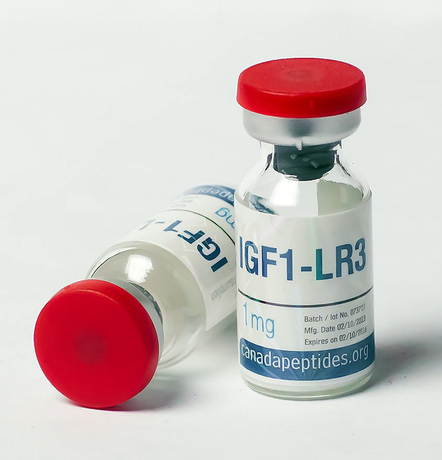Canada Peptides IGF1 LR3, insulin-like growth factor-1 (somatomedin C) – is the main representative of the family of insulin-like growth factors.
The area of the human body where Canada Peptides IGF1 LR3 will be created is the liver. There are prerequisites, which state that Canada Peptides IGF1 LR3 is produced directly in the muscles, and not, as previously claimed, that it is somehow brought by the bloodstream from the liver.
Canada Peptides IGF1 LR3 acts as an auto- and paracrine hormone, while the change in its content in the tissues occurs without the transformation of its concentration in the blood, and this change is modulated by binding proteins. Depending on the protein that binds Canada Peptides IGF1 LR3, the activity of such a complex can change dramatically. Blood serum proteins that bind Canada Peptides IGF1 LR3 are presented in 4 types: IGF1 LR3-binding protein of type 1, type 2, type 3 and alpha subunit, and later identified proteins that bind Canada Peptides IGF1 LR3, these are proteins of types 4 and 6. According to the analysis, 75% of Canada Peptides IGF1 LR3 in the blood is bound in a complex with type 3 protein (BSIGF-3), thus, it is the main protein factor limiting the action of IGF-1.
At low pH values, and this can be achieved by the accumulation of lactate (lactic acid) during the failure repetition, which is accompanied by a strong burning sensation in the target muscles, IGF-1 and IGF-2 can dissociate from the bound state under these conditions, but only by bypassing the stage of dissociation of the binding protein from the alpha subunit.
The protein that binds IGF1 LR3 is formed in the liver and protects against destruction, as well as prolongs the life of IGF1 LR3 in the circulation and in the regulation of their action, inhibits insulin-like actions and receptor binding of peptide in the liver and fat cells.
Canada Peptides IGF1 LR3 shows an anabolic effect on muscles and a health-improving effect on joints, ligaments, and liver.
Receptors and IGF1 LR3 (IGF)
Biological effects of Canada Peptides IGF1 LR3 are realized through receptors that are located in the plasma membrane of target tissue cells, according to IGF, they do not need to penetrate inside the cell, as for insulin and THG. But the receptors of the insulin itself will probably noticeably combine IGF, and IGF receptors weakly combine insulin, so the insulin-like action of IGF is mediated both by its own and insulin receptors. To increase the availability of receptors, it is necessary to carry out the largest "load" blood in the target muscle area, acidic decay products will accumulate, lactate in particular, pH values decrease and activate the dissociation of IGF-1 complexes bound by proteins. Loads with the greatest blood pumping produce a capillary network in this area, which contributes to the increase of receptors contacting circulating free IGF-1 in the blood.
As for metabolic effects, it has been established that IGF stimulates the growth of cartilage, the transport of amino acids, the synthesis of DNA, RNA, chondroitin sulfate, collagen, and all these processes are stimulated in cartilage tissue. In muscles, IGF-1 stimulates amino acid and glucose transport, collagen formation, and protein synthesis. In fat – stimulation of transport of sugars, oxidation of glucose to carbon dioxide, inclusion of glucose in lipids, suppression of lipolysis (analogous to the action of insulin, i.e. implemented through inhibition of the activity of the adenylatcyclase enzyme). The growth-stimulating effect of growth factors is 50-100 times that of insulin, but the sugar-lowering activity is only 1/13 of that of insulin.




There are currently no reviews for this product.
Your review will be the first.
Tell other users of the site about the advantages and features of the product, share your impressions and expert opinion.